Micron’s 20nm 128Gb MLC NAND was released in 2013 and hit the market in a consumable way as the first terabyte-class M500 SSD. The drive debuted at a price under $600 and proved to be a decent performer, though it is more a mainstream drive for consumers under the Crucial brand and for OEMs and system builders with the Micron flag. Today's release of the new similarly branded Crucial/Micron M550 expands on their personal storage line with improved performance, longer battery life, new capacity and form factor options, and an advanced feature set. The M550 SSD is specifically designed to meet the needs businesses and enthusiasts who are heavily involved with high-performance computing, ultrathin, and media/video applications. The M500 will stay in market, providing a balance of price and performance.
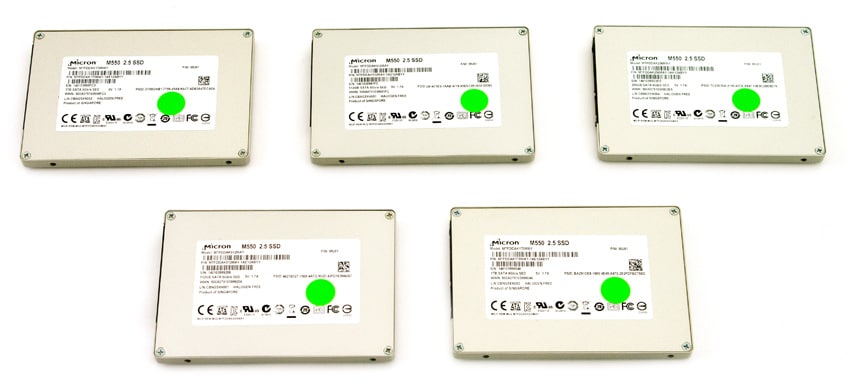
Performance-wise, the M550 is quoted to deliver 550MB/s for sequential read and 500MB/s for sequential write, as well as 95K IOPS random read and 85K IOPS random write. To reach these speeds, its core technology includes a Micron 20nm 64GB with 128GB NAND and a Micron custom firmware using a Marvell 88SS9189 controller. In addition, the M550 doesn’t require file compression, a NAND buffer, or system DRAM.
Micron has also implemented its industry-leading encryption into its new SSD, which includes AES 256-bit hardware encryption, meeting TCG Opal 2.0 and IEEE-1667 standards as well as being compatible with Microsoft eDrive. For further protection, the M550 has a redundant array of independent NAND (RAIN), protecting data at the component level, which is very similar to the way RAID is used with multiple drives. Crucial’s new SSD also uses a data integrity algorithm with four layers of defense against data corruption at the component level to safeguard the data’s integrity. The M550’s adaptive thermal protection maintains optimal operating temperatures, which allows the drive to dynamically adjust NAND activity based on usage demand.
To suit the needs of the many different types enterprises, the Micron M550 is available in three different form factors and in a plethora of capacities:
- 2.5-inch: 64GB, 128GB, 256GB, 512GB, and 1024GB
- mSATA: 64GB, 128GB, 256GB, and 512GB
- M.2 type 2280: 64GB, 128GB, 256GB, and 512GB
The more relevant "2.5 drives are priced at $ 99.99 (128GB), $168.99 (256GB), $336.99 (512GB), $530.99 (1TB). All drives are inclusive of a three-year warranty. For this review, we will be looking at 2.5" SATA form factor in 256GB, 512GB, and 1024GB (i.e. 1TB) capacities.
M550 Specifications
- NAND Technology: 20nm 64Gb/128Gb MLC
- Controller: Marvell 88SS9189
- Interface: SATA 6Gbps (SATA III)
- Types/Capacities
- 2.5”: 64/128/256/512/1024GB
- mSATA: 64/128/256/512GB
- M.2: 64/128/256/512GB
- DEVSLP: <3mW
- Sequential Read (up to): 550 MB/s
- Sequential Write (up to): 350 to 500 MB/s
- Advanced Features: Native Write Acceleration, Redundant Multistep Data integrity Algorithm, Ada Protection, Active Garbage Collection, Sleep Support
- Three-year warranty
Design and Build
The Crucial M550’s design is virtually the same as its predecessor, the M500, with a smooth and refined metal, yet durable, enclosure. Its metal build also allows it to be finger-print proof. The front of the drive features a sticker that labels the drive with Crucial logo and specific model number.
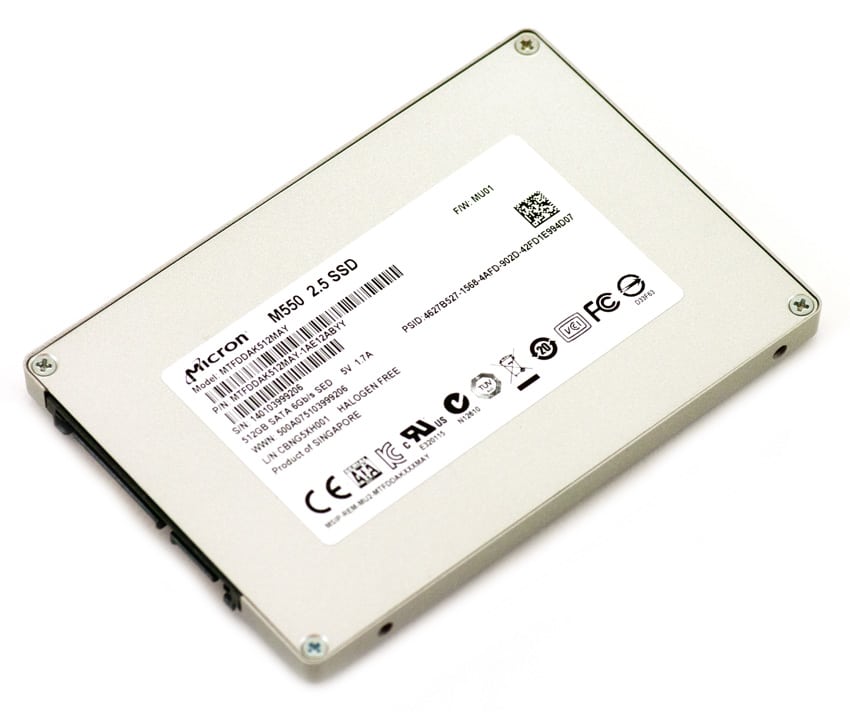
The side profiles present the screw holes that enable the drive to be mounted properly. While many drives are still 9.5mm, the M550 has a slim 7mm profile. The M550 fits well in the 7mm Ultrabook space or in most any other application. The drive is rounded out with standard SATA power and data connectors on the front.
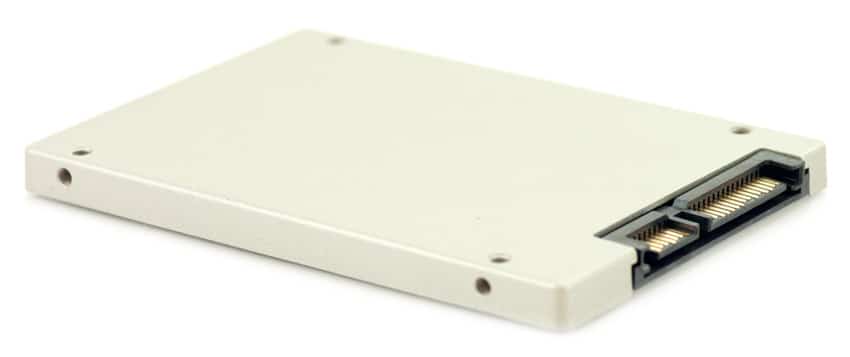
The Crucial M550 1TB model utilizes the newer Marvell 9189 controller as well as 16 total NAND die, meaning that each NAND die is 64GB. The new models also give users more capacity, for example a 512GB capacity instead of 480GB or 1024GB vs 960GB that the M500 offered.
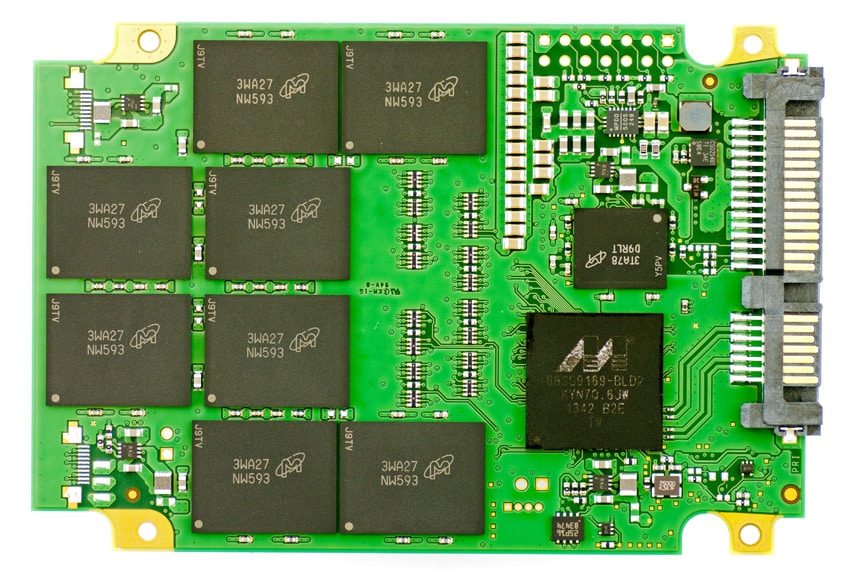
Consumer Synthetic Workload Analysis
All consumer SSD benchmarks are conducted with the mid-range StorageReview Consumer Testing Platform. The comparables used for the review below include:
- Crucial M500 (480GB, Marvell 9187, Micron 20nm MLC NAND, SATA)
- OCZ Vertex 150 SSD (240GB, Indilinx Barefoot 3 BF3-M10, 19nm MLC NAND, SATA)
- OCZ Vertex 460 (240GB, Indilinx Barefoot 3 BF3-M10, Toshiba 19nm MLC Flash, SATA)
- Samsung SSD 840 EVO (250GB, 400MHz Samsung 3-core MCX controller, Samsung 1x nm Toggle NAND Flash, SATA)
- Seagate 600 SSD (120GB, Link-a-Media LM87800, 19nm MLC NAND, SATA)
- Corsair Force LS (240GB, 19nm Toshiba MLC, SATA)
- Intel SSD 730 (480GB, Intel PC29AS21CA0 controller, 20nm Intel MLC NAND, SATA)
All IOMeter figures are represented as binary figures for MB/s speeds.
Our first test measures 2MB sequential performance. The Crucial/Micron M550 256GB SSD was the top M550 model measuring read and write speeds of 500.2MB/s and 471.8MB/s write respectively. Its higher capacity brethren, 512GB and 1TB, measured 493.6MB/s read and 471.0MB/s write and 486.1MB/s read and 470.8MB/s respectively. The top performer in the read column was the OCZ Vector 150 240GB while the write column's winner was the Samsung SSD Evo 250GB.
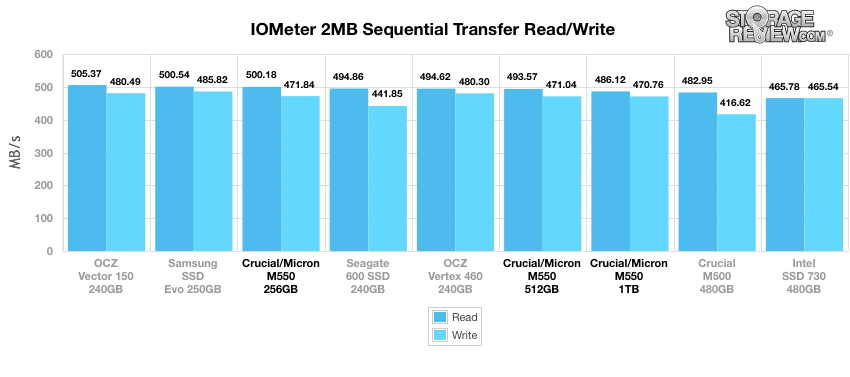
Looking at 2MB random transfer performance, the M550 256GB scored 488.2MB/s read and 473.0MB/s write; the M550 512GB scored 491.6MB/s read and 468.6MB/s write; and the M550 1TB 480.5MB/s read and 472.7MB/s write. While the Samsung SSD Evo 250GB was the top performer for read activity with 492.9MB/s, its write performance for random transfers was significantly lower than all of the other comparables at 240.0MB/s.
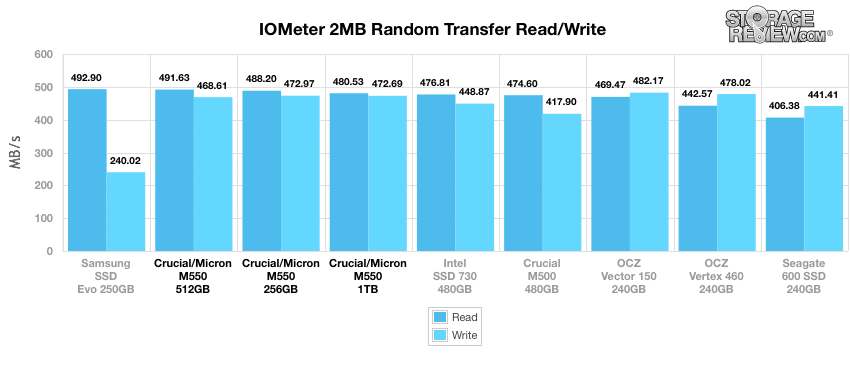
Switching to smaller 4K random transfers, the M550 drives continues to perform well boasting 7,806 IOPS read activity and 19,704 IOPS write activity for the 256GB model. The 512GB and 1TB capacities showed similar results with 7,349 IOPS read and 20,443 IOPS write and 7,279 IOPS read and 18,618 write respectively.
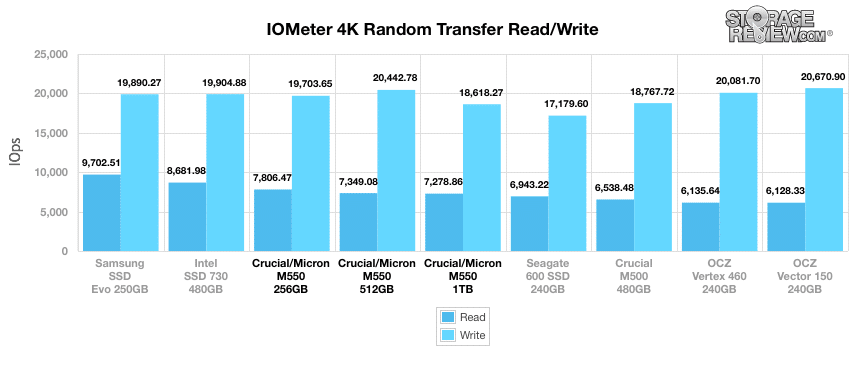
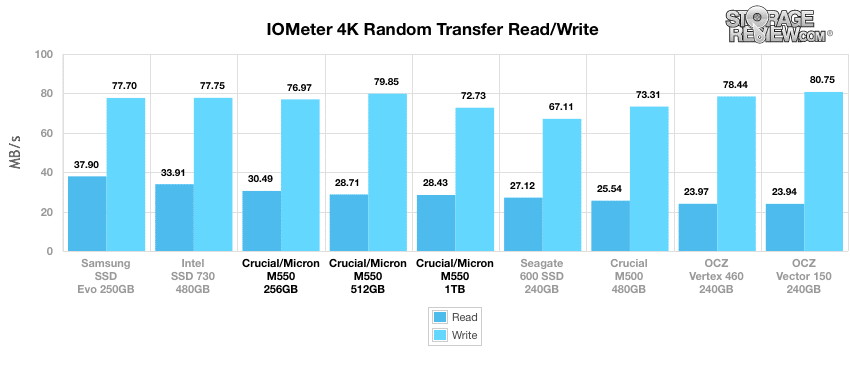
For read activity, M550 SSDs maintained their great performance, especially the 1TB model which took top place with its range of 7,333 IOPS up to a blistering 100,405 IOPS.
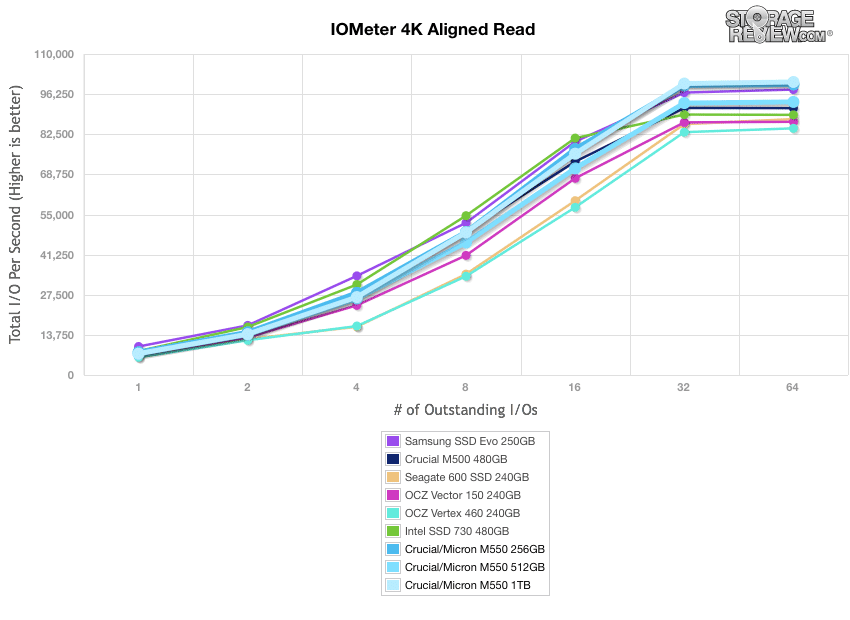
In our next 4K test, we move to a workload with 100% write activity, which scales from 1QD to 64QD. In the aligned write setting, the M550 256GB scaled from 21,249 IOPS up to 88,064 IOPS; the M550 512GB scaled from 20,037 IOPS up to 88,166 IOPS; and the M550 1TB scaled from 21,045 up to 88,260 IOPS, all of which ranked at the top of the leaderboard by 64QD.
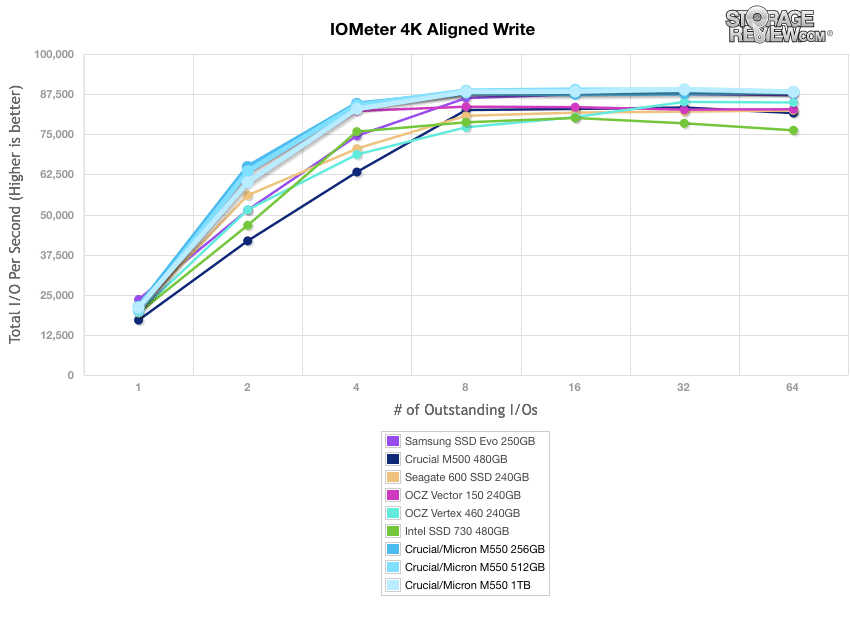
Comparing average write latency, the M550 SSDs performed all over the board with the 512GB model posting the best results of the family.
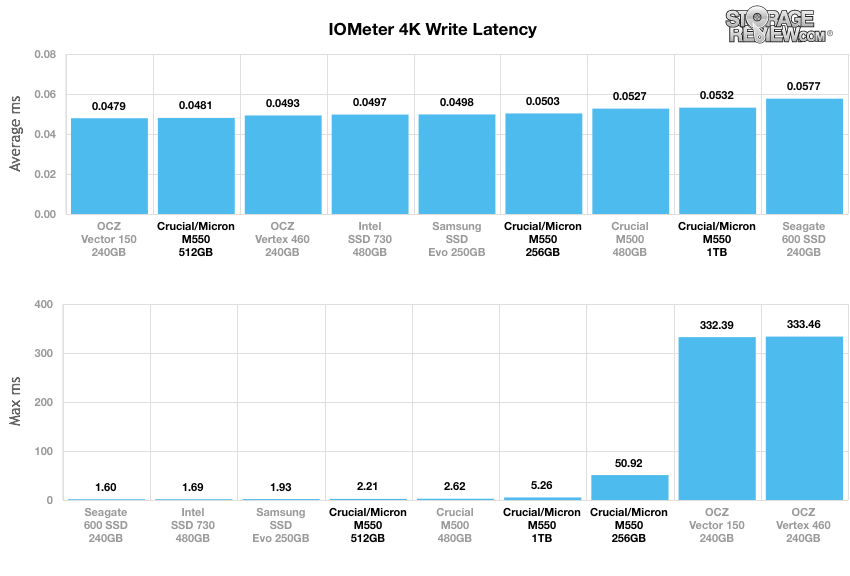
Our last series of synthetic benchmarks compare the hard drives in a series of server mixed-workloads with a queue depth of ranging from 1 to 128. Each of our server profile tests has a strong preference towards read activity, ranging from 67% read with our database profile to 100% read in our web server profile. In all of our mixed workloads, the M550 SSDs ranked anywhere near the upper middle to the lower part of the leaderboard.
The first is our database profile; with a 67% read and 33% write workload mix primarily centered on 8K transfer sizes. For this benchmark, the M550 drives boasted Q128 results of 41,729, 40,467, and 42,489 IOPS for the 256GB, 512GB, and 1TB respectively.
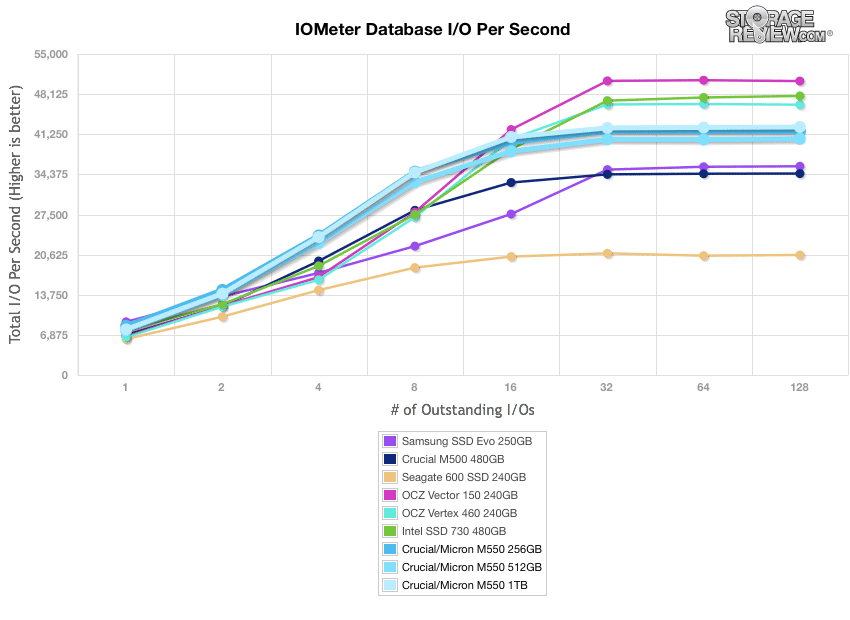
The file server profile has 80% read and 20% write workload spread out over multiple transfer sizes ranging from 512-byte to 64KB. The M550 1TB was the top perform of the Micron SSDs, with a Q128 IOPS of 29,245.
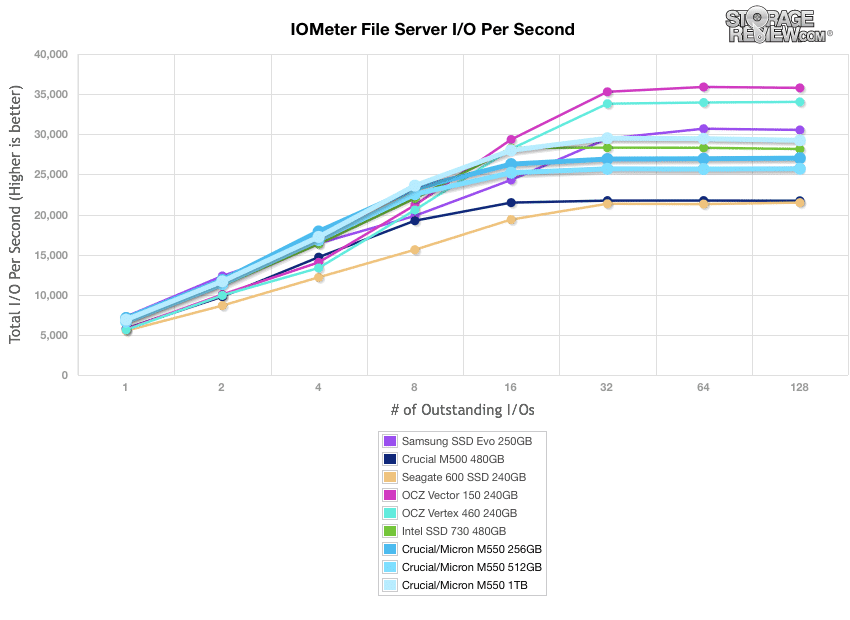
Our web server profile is read-only with a spread of transfer sizes from 512-byte to 512KB. The M550 SSD family was at the bottom of the pack in this category boasting 21,533 IOPS, 21,133 IOPS and 23952 for the 256GB, 512GB, and 1TB respectively by the Q128 mark.
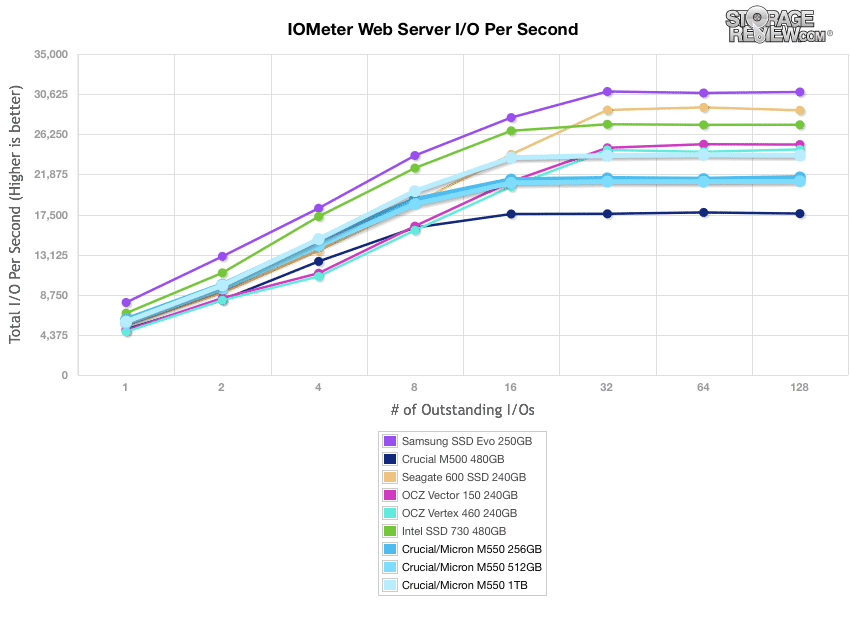
The last profile looks at workstation activity, with a 20% write and 80% read mixture using 8K transfers. By Q128, the M550 family performed near middle of the rankings.
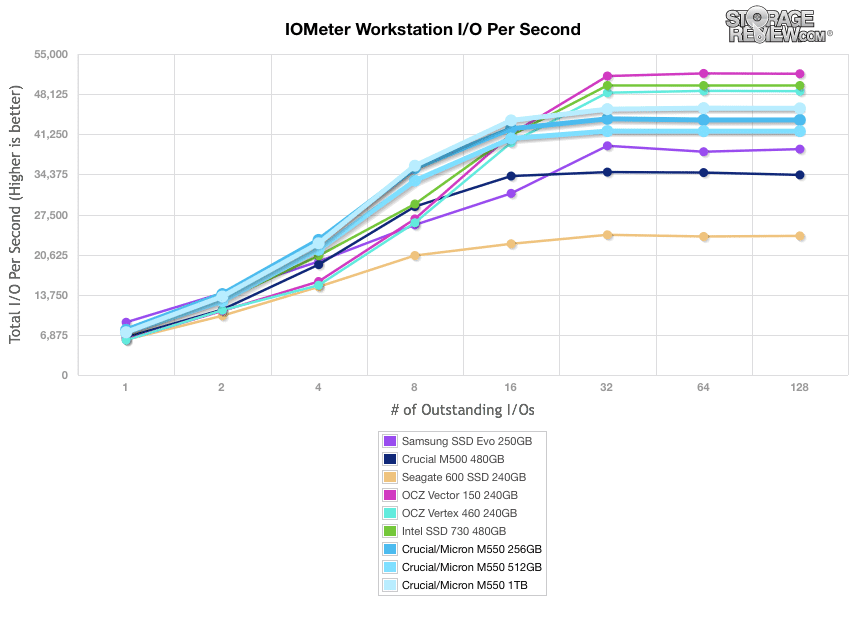
Consumer Real-World Benchmarks
For the average consumer, trying to translate random 4K write speeds into an everyday situation is pretty difficult. It helps when comparing drives in every setting possible, but it doesn't exactly work out into faster everyday usage or better game loading times. For this reason we turned to our StorageMark 2010 traces, which include HTPC, Productivity, and Gaming traces to help readers find out how a drive might rank under these conditions.
The first real-life test is our HTPC scenario. In this test we include: playing one 720P HD movie in Media Player Classic, one 480P SD movie playing in VLC, three movies downloading simultaneously through iTunes, and one 1080i HDTV stream being recorded through Windows Media Center over a 15 minute period. Higher IOps and MB/s rates with lower latency times are preferred.
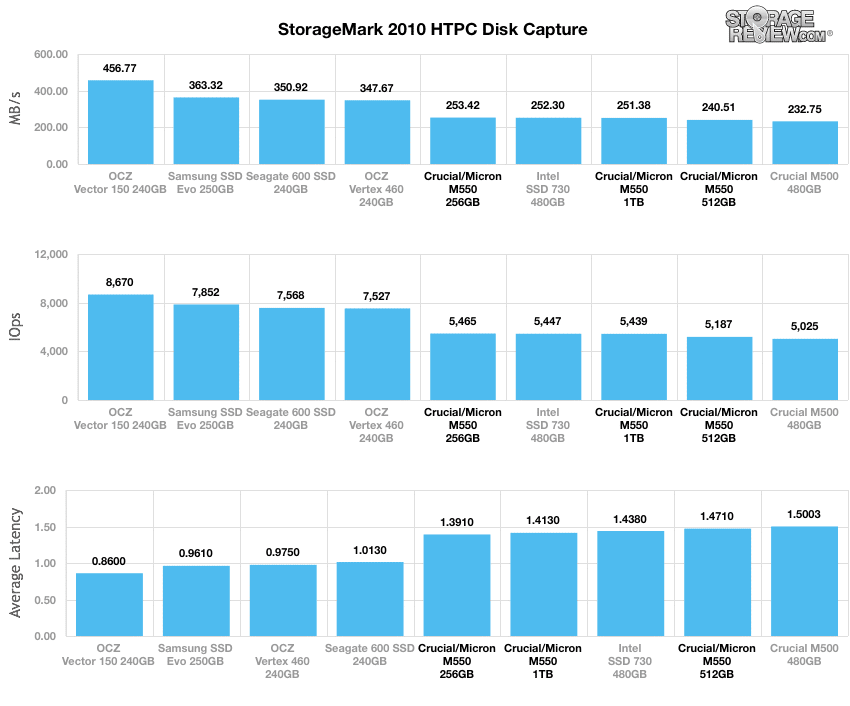
In our HTPC profile, the M550 family ranked at the lower middle and bottom of pack in all of our tests with the 512GB taking second last place in all of the categories.
Our second real-life test covers disk activity in a productivity scenario. For all intents and purposes this test shows drive performance under normal daily activity for most users. This test includes: a three hour period operating in an office productivity environment with 32-bit Vista running Outlook 2007 connected to an Exchange server, web browsing using Chrome and IE8, editing files within Office 2007, viewing PDFs in Adobe Reader, and an hour of local music playback with two hours of additional online music via Pandora.
In our Productivity trace, the M550 SSDs continued to struggle keeping up with the OCZ drives, coming it near the bottom of the pack only beating its M500 brethren and Intel drive.
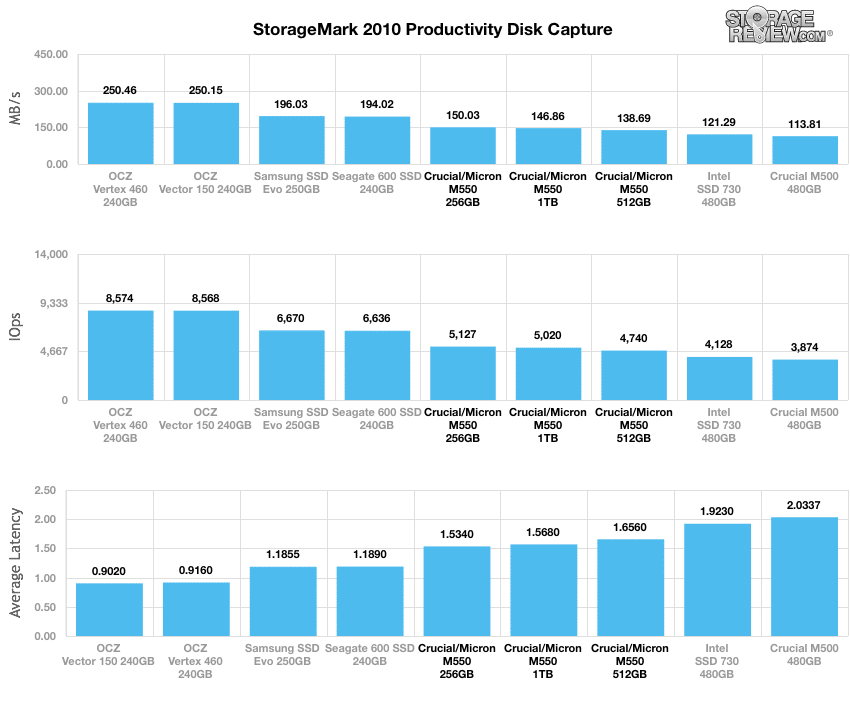
Our third real-life test covers disk activity in a gaming environment. Unlike the HTPC or Productivity trace, this one relies heavily on the read performance of a drive. To give a simple breakdown of read/write percentages, the HTPC test is 64% write, 36% read, the Productivity test is 59% write and 41% read, while the gaming trace is 6% write and 94% read. The test consists of a Windows 7 Ultimate 64-bit system pre-configured with Steam, with Grand Theft Auto 4, Left 4 Dead 2, and Mass Effect 2 already downloaded and installed. The trace captures the heavy read activity of each game loading from the start, as well as textures as the game progresses.
In our read-intensive Gaming trace, the M550 family of SSDs really picked up its performance, producing results right at the top of the pack with the 256GB model taking top spot in every category with a blistering 488.6MB/s and an IOPS of 9,250.
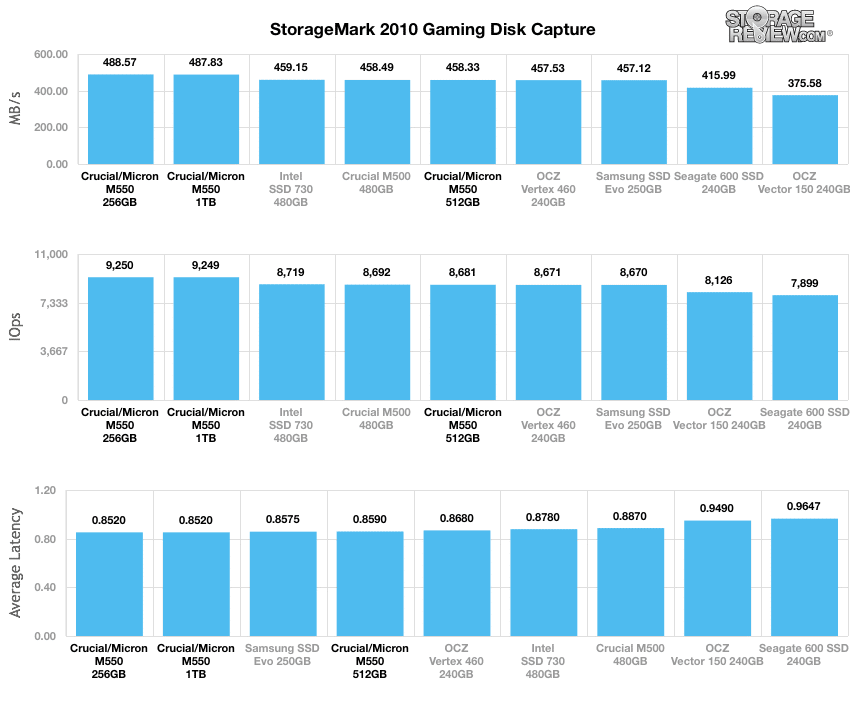
Power Consumption
Low idle power consumption is a very important feature when it comes to SSDs and their overall power management since they spend much of their life-time in an idle state.
In our power tests, we measured idle power consumption from M550 family of SSDs at 1.11W, 1.04W, and 1.00W for the 256GB, 512GB, and 1TB respectively. During sequential write and read activity the drives scored 3.93W/2.52W, 4.37W/2.46W, and 4.53W/2.46W respectively.
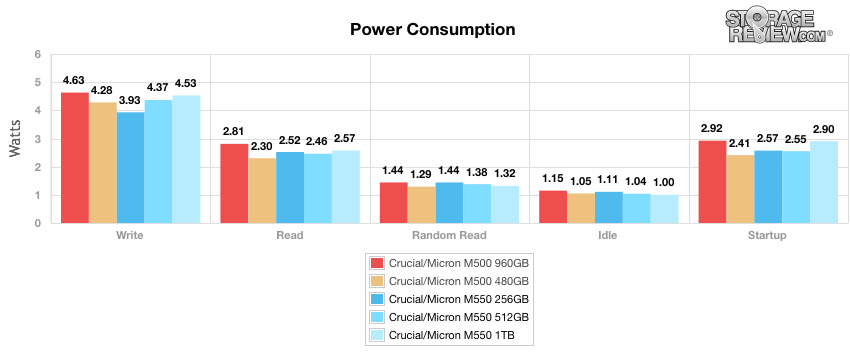
Conclusion
The Crucial/Micron M550 line (Crucial for retail, Micron for OEMs) is designed as a high-performance SSD for enthusiasts and is equipped with SATA 6Gb/s, 20nm NAND, duty-optimized firmware and features the Marvell 88SS9189 controller. One of the biggest upsides to the M550 family is that it comes in three form factors in a variety of capacities in order to suit the needs of different enterprises and businesses: 2.5-inch, mSATA, and M.2 (64GB, 128GB, 256GB, 512GB, and 1024GB).
As far as performance goes, the Micron M550 SSDs performed very well in many of our tested categories and though it did outperform its M500 predecessor in virtually every category, the M550 is really only a modest improvement in most cases. In our real-world workloads, it generally performed below par, though it is proved to be the strongest performer in our read-intensive gaming benchmark. When measuring it's performance in single workloads, the M550 line placed in the upper echelon in 2MB sequential speeds, which remained in that way during our 4K tests. During our mixed workload performance benchmarks, the M550 ranked middle of the pack falling behind many of the other recently released SSDs from other vendors.
Overall, the Micron M550 family are decent line of performance SSDs. It's targeted to both businesses and consumer who require a drive capable of high-performance computing, though it doesn't really blow away the competition. That's been the Micron SSD M.O. though, the m4 and M500 before have shown to be capable and reliable SSDs, while generally not performance category leaders. Micron does offer these drives at a competitive price though, which combined with the pedigree of compatibility, reliability and endurance, makes for a compelling offering.
Pros
- Good price
- Ships in a variety of form factors in several capacities
- Proven history of reliability and support
Cons
- Not quite up to par in our real world benchmarks
Bottom Line
The Crucial/Micron M550 provides a progressive update over the M500, giving consumers and OEMs a drive platform with a lengthy history of reliability and endurance.
Crucial M550 at Amazon



 Amazon
Amazon